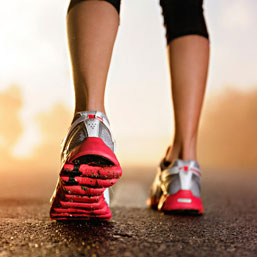- Like
- SHARE
- Digg
- Del
- Tumblr
- VKontakte
- Flattr
- Buffer
- Love This
- Save
- Odnoklassniki
- Meneame
- Blogger
- Amazon
- Yahoo Mail
- Gmail
- AOL
- Newsvine
- HackerNews
- Evernote
- MySpace
- Mail.ru
- Viadeo
- Line
- Comments
- Yummly
- SMS
- Viber
- Telegram
- JOIN
- Skype
- Facebook Messenger
- Kakao
- LiveJournal
- Yammer
- Edgar
- Fintel
- Mix
- Instapaper
- Copy Link
 The Important of Proper Footwear
The Important of Proper Footwear
It doesn’t matter whether you’re talking about your running gear or your sexiest pair of stilettos—if your shoes don’t fit your feet properly, then you are placing your body under serious threat.
Your foot takes the full impact of your weight, meaning an injury in this area can not only halt your training immediately but may even prevent you from walking properly altogether.
Sidestep these concerns by learning what conditions you’re up against, and the best ways to fight them.
5 Painful Conditions Caused by Bad Footwear
#1. Plantar Fasciitis
Without proper arch support in your running shoe, you might find yourself falling victim to the dreaded plantar fasciitis. Characterized by a sharp stabbing pain at the bottom of the heel, this condition is very common, with around 1 in 10 people developing the inflammation in their lifetime, with a large percentage of those being runners.
If you find yourself an unfortunate victim of plantar fasciitis, seek out immediate relief from muscle soreness and strained ligaments by gently rolling your foot along a massage ball, while experimenting with an ice pack and regularly stretching out these tendons. Thankfully, many runners report that they can train through the pain, but if the problem persists, rather speak to a professional, discussing what special orthotic options are available.
#2. Achilles Tendinitis
Achilles tendinitis and plantar fasciitis are distant relatives, both very similar in the ways where an ill-fitted footwear choice may provoke inflammation, often aggravated by a runner who has increased their training. Once again, applying ice with a lot of stretching will help nurse the condition back to health, and a change of shoes with orthotics included is recommended.
The main differences between these two problems, however, is the specific area of pain. Achilles tendinitis strikes where a tired calf muscle swells at the heal, placing strain on the Achilles itself, which over time will lose elasticity and then potentially tear. And unlike plantar fasciitis, any activity can severely worsen this trauma, which is why it’s imperative you pause all training until the inflammation has completely calmed down.
#3. Bunions
When wearing shoes which force your toes together for a prolonged amount of time, bunions may develop, which is not an attractive development. This condition is defined by a large bump which grows on the side of your big toe and pushes it inwards, causing a noticeable deformity. For some, this inflammation can make it painful to walk, while others find it to be a relatively painless affair, but either way, bunions have a reputation for progressively growing bigger and uglier over time.
The first step to freedom is changing your footwear into a low heel with supportive arches and plenty of wiggle room, while immediately getting rid of those narrow toed high heels once and for all (the primary reason why bunions are much more common for women). Follow this action with a visit to your doctor, perhaps discussing a surgical procedure to remove the offending bump if need be.
#4. Blisters
Blisters are an annoying bubble of liquid which most people will experience at some point in their lives. When these soft pockets pop up on the feet, it’s usually a result of sweaty skin repeatedly rubbing against incorrectly fitted shoes after walking or standing up for an extended period of time. These pillows of fluid are the body’s way of protecting the sensitive over-rubbed skin beneath, so you should actually be somewhat grateful for them.
Luckily, blisters are not a serious issue, and the safest plan is to simply leave them alone, allowing nature to take its healing course in its own time. However, if you need to drain one, be very careful and only ever puncture the skin with a sterile utensil. Once this is done, apply an antibiotic cream, keep the area covered with a bandage, and speak to your doctor if these raised areas are a regular occurrence.
#5. Ingrown Toenails
When a toenail isn’t trimmed properly and is relentlessly pressured by a compact shoe, it can lose its way and gradually grow into the groove of your toe. This condition can cause discomfort, pain, and swelling, all of which creates a wound which bacteria can thrive in, becoming infected rather easily.
The Bottom Line
As always, prevention is your greatest ally, so starting right now, ensure that you’ve cut your toenails straight across, never in a curved shape and never too short, while maintaining clean, dry toes at all times.
At the first sign of any problems, throw away your pointed-tipped shoes, soak your feet in warm water with Epsom salt, and then wash them with antibacterial soap. If the condition worsens, you may need to get a small wedge of nail plate removed surgically.

 The Important of Proper Footwear
The Important of Proper Footwear
